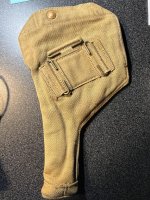Are the holsters hard to come by?
I don't know beans from apple butter about the holsters! I do know the difference between collectibles and junk. I learned from one of THE collectors---Ray Cheely. The difference is three things:
CONDITION---CONDITION-----and CONDITION!!!
The reason I told you to count your blessings for the holster is because of its condition.
Any and everything that looks like it's new, or damn near new is what you want to take home with you-----including even G.I. holsters---if such as that is your interest---and every now and then even if it isn't.
The best example I have of why is a prolonged dry spell when I couldn't find the S&W's I was after. I was moaning and groaning about that to a Ruger collector friend---very likely THE Ruger collector in the whole country--and he posed an interesting question: "Why don't you try Rugers for a spell?"
So I did. I collected 3 screw single actions (my favorites)---ended up with each and every one of them over 7 years---and when I say each and every, I'm talking about every model in every caliber in every barrel length---34 guns in all---spent maybe $20,000 on them over those 7 years----don't really know.
Then there came a time when I was running out of room in my display case, and something had to go. It wasn't going to be any of my S&W's! Off I go to David Carroll's with my Rugers to have him get rid of them. Now David didn't know all that much about Rugers, but he knew folks who did----and they said those 34 guns would very likely fetch upwards of $40,000, maybe a bit more----and I was a happy camper!
Now David is very likely way up at the top of the collectible firearms dealers list somewhere---suggesting he knows how to sell this stuff, especially stuff in top condition, which seemed to be his specialty------including even Rugers. So--when all was said and done, those 34 Rugers (all in top condition) fetched in the mid 50's---and I was an even happier camper!
CONDITION--CONDITION--CONDITION!!!
The bottom line of all this condition business is top condition collectibles either hold their value or appreciate over time. Lesser condition items depreciate.
Are guns (or their accessories) a good investment? Not particularly, compared to other options; but that isn't why we bought them in the first place. We bought them to have them and to enjoy having them.
A top condition collectible is to be admired----never mind what it is.
Ralph Tremaine






